Amazon Sponsored Display Ads are a powerful PPC tool that lets you re-engage shoppers even after they’ve left your product listing on Amazon or across the web. They’re designed for retargeting and reaching high-intent audiences, making them a great way to increase brand awareness and drive more conversions.
In this guide, I’ll walk you through what Sponsored Display Ads are, how to launch your first campaign, and when to use them as part of your broader Amazon PPC strategy. Let’s start by explaining exactly what Sponsored Display Ads are.
What Are Amazon Sponsored Display Ads?
Amazon Sponsored Display Ads are a type of pay-per-click (PPC) advertising that helps your product reach shoppers on and off Amazon. These ads use Amazon’s audience data to retarget potential buyers who’ve shown interest in your product, a similar product, or a relevant category.
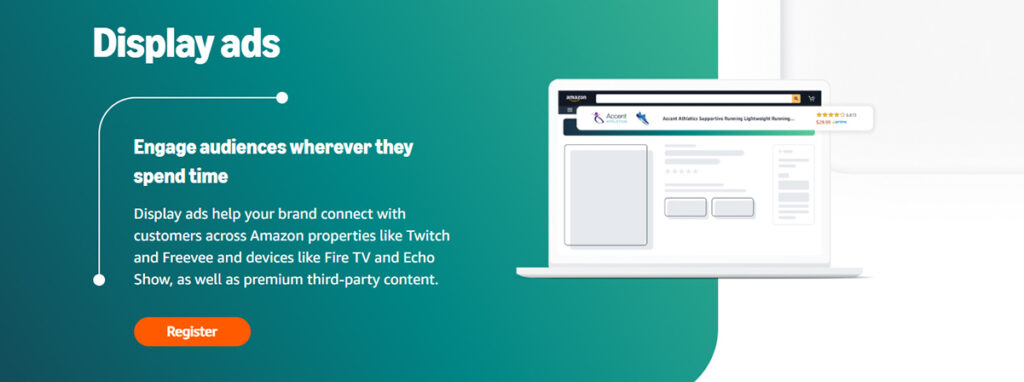
Unlike Amazon Sponsored Products or Sponsored Brands, which mostly show up within search results and on product pages, Sponsored Display Ads have many more placement options. They can appear:
- On Amazon’s product detail pages
- In Amazon search results
- On the Amazon homepage
- On third-party websites and apps that are part of Amazon’s ad network
What makes Sponsored Display powerful is its audience targeting. You’re able to re-engage people who didn’t buy the first time, reach shoppers browsing competitor listings, or introduce your product to new audiences based on their interests. Combine this with the ability to target shoppers both on and off Amazon, and Sponsored Display becomes a great way to stay visible throughout the buying journey, even after someone leaves your product page.
Sponsored Display vs Sponsored Products and Brands: What’s the Difference?
If you’re just starting with Amazon ads or have only used Sponsored Products so far, it can be confusing to understand how each ad type works and when to use them. Amazon offers three main ad formats inside Seller Central, each with different strengths depending on your goals.
Sponsored Products
These are the most common ads on Amazon. They show up in search results, on product detail pages, and even in carousels like “4 stars & up” or “Customers also bought.” These ads look just like regular product listings and don’t allow custom images or video. You target keywords or specific ASINs, making them a go-to option for capturing high-intent shoppers already searching for something specific.
Sponsored Brands
These ads are only available to brand-registered sellers and are designed to promote your brand or a set of products. They appear in premium placements, like the top of search results, and can feature your brand logo, a custom headline, and multiple products. Sponsored Brands support several formats, including image-based ads and video ads, giving you more creative control and a chance to drive clicks across a full product line.
Sponsored Display
This ad type is built around targeting audiences and product detail pages, not just search results. Sponsored Display ads can appear both on Amazon (like product detail pages and search results) and off Amazon (on third-party sites and apps through Amazon’s ad network). You can choose between image or video ads, and you also have the option to pull creative assets directly from your product listing. These ads are especially useful for retargeting shoppers who’ve viewed your products or similar ones, and for keeping your brand visible throughout the customer’s browsing journey.
Where Do Sponsored Display Ads Appear?
One of the biggest strengths of Sponsored Display Ads is how many different places your ad can appear. Unlike other Amazon ad types, these ads aren’t limited to search results or product pages. Amazon can show them on product detail pages, alongside search results, on the homepage, and even off Amazon—across apps and websites in its ad network.
Here are some of the most common placement options:
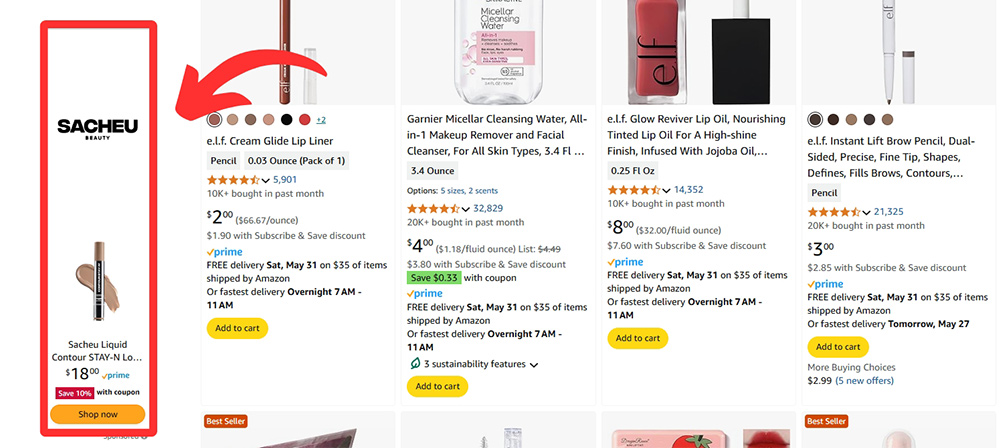
On Amazon
Sponsored Display Ads can appear in several locations across Amazon’s site and app. Some of the most common placements include:
- Product detail pages: You’ve probably seen these ads near the top of a listing, right under the product title or just below the Buy Box. There are also placements lower on the page, near the customer reviews and product recommendations.
- Search results: On desktop, Display ads can show up on the left-hand side of the results page
- Amazon homepage: In some cases, Amazon will show Display ads directly on the homepage. These placements are typically audience-targeted and used to catch shoppers before they’ve even started a search.
- Mobile placements: If a customer is shopping on their phone, they’ll still see your Sponsored Display Ads in key locations like detail pages and search results, just formatted to fit mobile screens.


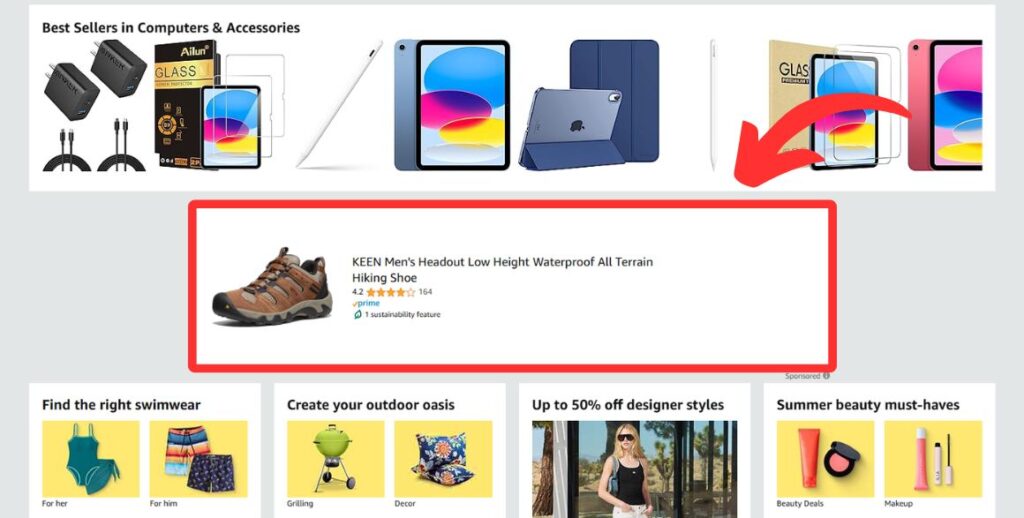
Off Amazon
Sponsored Display Ads can also appear on websites and apps outside of Amazon. These off-Amazon placements are part of Amazon’s larger DSP (demand-side platform) network. Your ads may be shown on popular sites owned by Amazon, like:
- Twitch
- IMDB
- Goodreads
They can also appear across thousands of third-party websites and apps that are part of Amazon’s ad network. This expands your reach beyond people actively shopping on Amazon and puts your products in front of relevant audiences based on their browsing and shopping behavior.

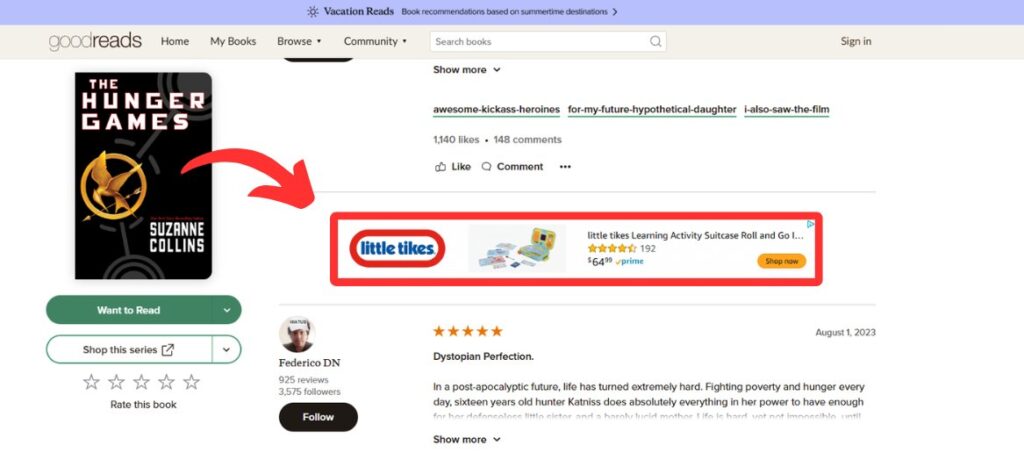
Who Can Use Sponsored Display Ads?

To run Sponsored Display Ads, you’ll need two things:
- A professional seller account
- Enrollment in Amazon Brand Registry
Brand Registry is what gives you access to advanced advertising features like Sponsored Brands and Sponsored Display, along with several features to both market and protect your brand on Amazon. There is no cost to join the Brand Registry, but you will need an active or pending trademark to sign up. This is Amazon’s way of making sure you actually own the brand you’re trying to promote.
For more information on the sign-up process, along with a breakdown of all of the key features, check out our complete guide to Amazon Brand Registry.
What Targeting Options Do Sponsored Display Ads Offer?
Sponsored Display works differently from other Amazon ad types because it doesn’t use keyword targeting. Instead, Amazon gives you two powerful ways to reach shoppers: Contextual Targeting and Audience Targeting. Each one works differently, and both can be effective depending on your goals.
Contextual Targeting
Contextual targeting means your ads show up based on the content the shopper is currently viewing. You can choose to target by product categories or specific ASINs.
If you go with category targeting, Amazon lets you either add the entire category or refine it. Refining gives you more control—you can set a price range and star rating to filter the placements. For example, you could choose to only display your ads on listings priced between $30–$50 and rated under 4 stars. These filters can be very useful as you’re able to guarantee that your ad will only be shown on product pages with a lower review score and worse pricing than your own.
As you may have guessed, product targeting lets you choose specific product listings for Amazon to display your ad. You can enter ASINs manually, search for products, or upload a list. This works great if you know exactly which listings your ideal customer is browsing.
Contextual targeting is simple to set up and ideal when you want to win shoppers directly on product pages where buying intent is high.
Audience Targeting
Audience targeting works differently. Instead of placing your ad based on the content someone is viewing, Amazon builds audience segments based on shopping behavior.
You’ll have three options here:
- Amazon Audiences: Let’s you target shoppers based on their interests, lifestyle, life events, etc. For example, you can target shoppers who own a vehicle, are environmentally conscious, or have shown an interest in travel. If you have any experience running Facebook ads, this is similar to Facebook targeting.
- Views: Reach customers who viewed specific product pages in a particular timeframe (7, 30, 90 days, etc). You can choose your own products, a complimentary product, or a competitor’s listing. This option is great for creating retargeting campaigns for customers who have viewed your product page but have not made a purchase yet.
- Purchases: Similar to “View”, but this time you’re targeting shoppers who have purchased particular products. Once again, you are able to target any product, including your own. You can use this to promote refills, accessories, or even launch new products to existing customers.
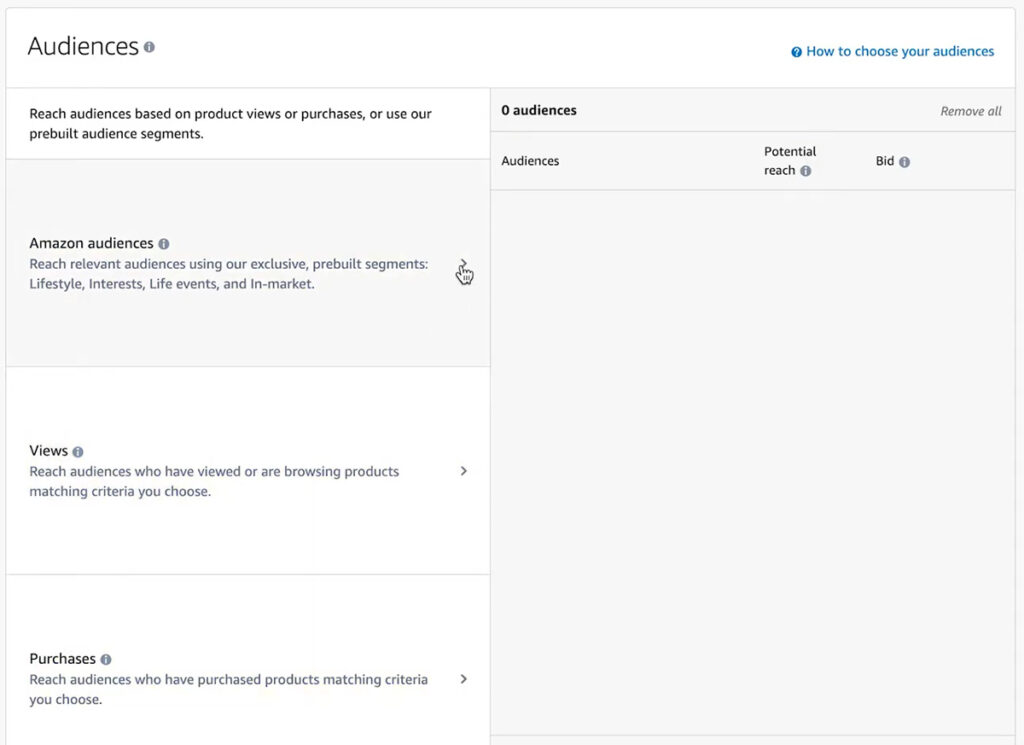
How to Set Up an Amazon Sponsored Display Campaign
If you’re ready to test Sponsored Display ads, this step-by-step guide will walk you through the setup process, from campaign settings to ad creative, so you can get your campaign off the ground without any issues.
Step 1: Log In and Start a New Campaign
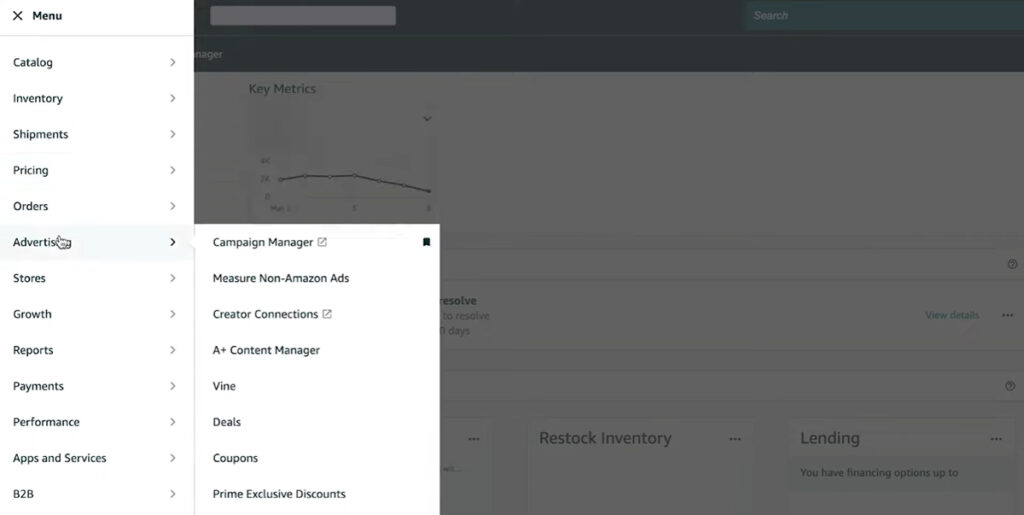
To get started, log into your Amazon Seller Central account. In the top navigation bar:
- Click the “Advertising” tab
- Choose “Campaign Manager.”
- Click the “Create campaign” button
You’ll land on a page where you can select your campaign type. Select Sponsored Display and click “Continue.”
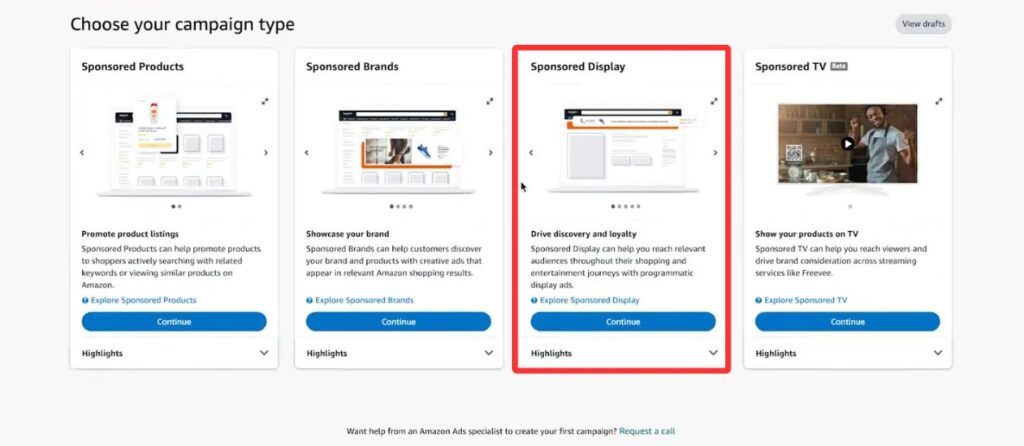
Step 2: Set Your Campaign Settings
Once you’ve selected “Sponsored Display,” you’ll move on to the “Create campaign” page. Your first step is to fill out the basic settings for your campaign. This includes creating a name, assigning it to a portfolio, setting your start and end dates, daily budget, and creating an ad group name.
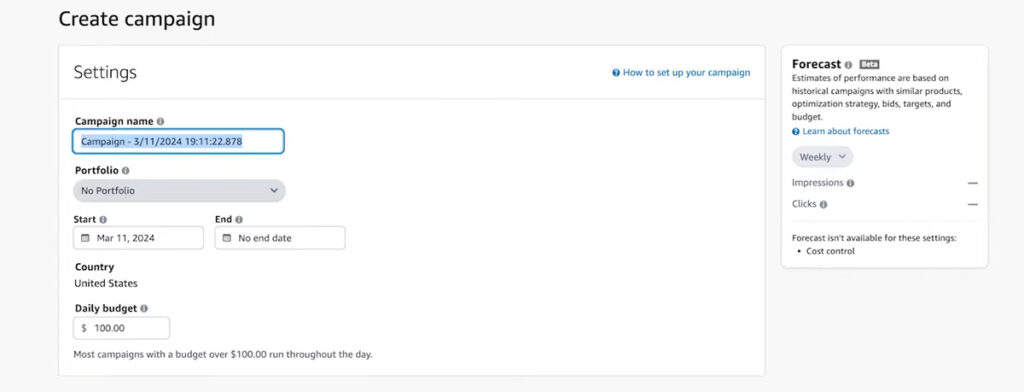
Campaign Name: Give your campaign a name that clearly identifies its purpose. For example, “Retargeting – Main ASIN – May 2025.” This is important because as your business grows and you launch more and more campaigns, you’ll want to make sure everything is organized and easy to navigate.
Portfolio: Portfolios are optional, but they’re a great way to group similar campaigns together. For example, I like to create separate portfolios for product launches, retargeting, and evergreen campaigns. This makes reporting easier and keeps things tidy as your account grows.
Start and End Dates: You can start the campaign immediately or schedule it for the future. In 99% of cases, I recommend leaving the end date blank unless you’re running a short promotion or having a very specific reason to do so.
Daily Budget: You’ll notice that Amazon’s default suggestion is $100/day, but that’s often too high for most new sellers. I’ve had good results with budgets as low as $10–$20 per day. Just keep in mind: if your budget is too low, Amazon might struggle to gather enough data, making it difficult to optimize your campaign.
Step 3: Choose Your Optimization Strategy

Next, you’ll choose how Amazon should optimize your campaign. There are three options here: Reach, Page Visits, and Conversions.
- Reach: This option focuses on getting your ad seen by as many people as possible. It uses a VCPM (cost per 1,000 viewable impressions) model. That means you’re paying for views, not clicks. Unless you’re a large brand trying to build awareness (think Nike or Pepsi), this usually isn’t worth it.
- Page Visits: This uses a CPC (cost-per-click) model and focuses on driving traffic to your product detail page. It can be a good option if your product has multiple variations, since the “Conversions” strategy only optimizes for a single ASIN. For example, if you are selling clothing with several colors and sizes, you might want to test page visits as an optimization strategy.
- Conversions: For 99% of sellers, this is the best choice. It also uses a CPC model but focuses on getting actual sales. Amazon will serve your ad to shoppers who are most likely to buy, not just click. In my experience, this leads to better ROAS and more efficient ad spend.
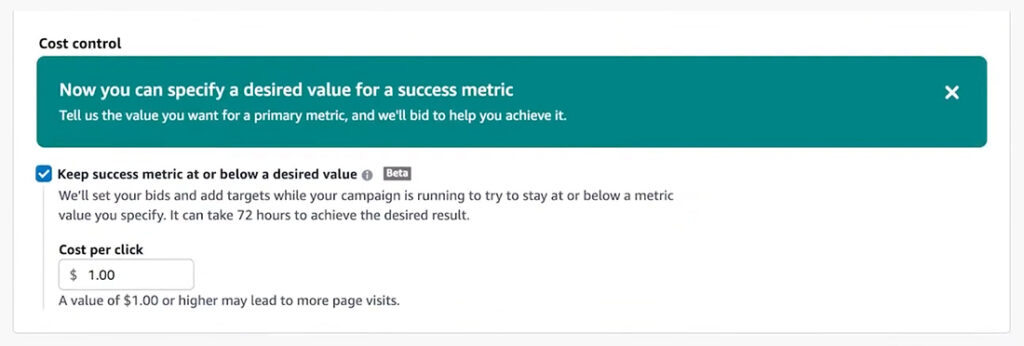
Right below this section, you’ll see something called Cost Control. It’s a newer feature that lets you set a target cost-per-conversion. You can test it out if you like, but I don’t recommend enabling it just yet—it’s still in its early days and often limits performance instead of helping.
Step 4: Choose Your Ad Format
Next, you’ll decide how your ad will appear to shoppers. Amazon gives you two format options for Sponsored Display: Image or Video.
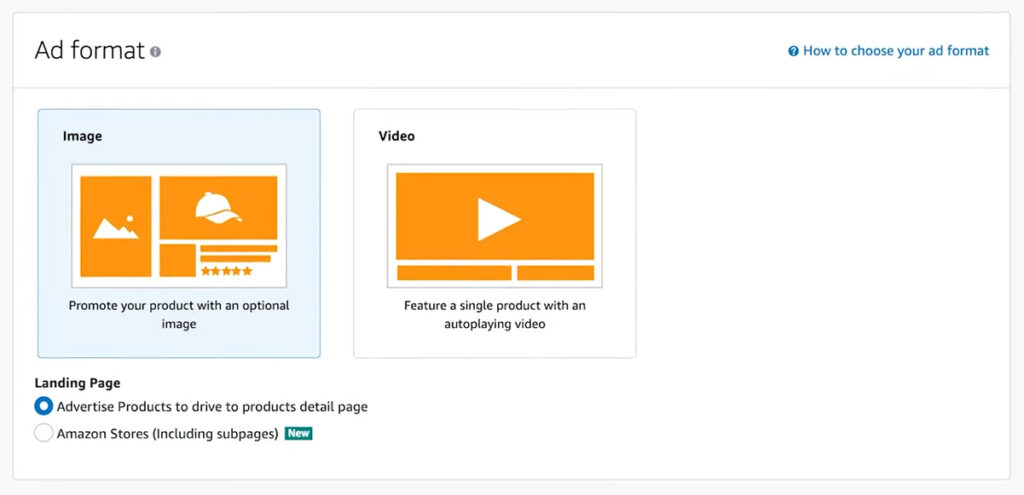
Image Ads: This is the default format and what most sellers start with. You have the option to upload a custom image to use with your ad, but you also have the option to use your product listing or any product image you’ve previously uploaded to Amazon. In other words, you can run a Sponsored Display ad without uploading anything custom, and honestly, that’s completely fine.
Video Ads: Your second option is to upload a short video instead of a static image. These autoplay without sound as shoppers scroll, and that movement alone can help your ad stand out. If you have a product video available or have the means of making one, I recommend giving this format a try. I’ve had a Sponsored Display video campaign outperform static ads by 2x in some niches, especially when showing how a product works in real life.
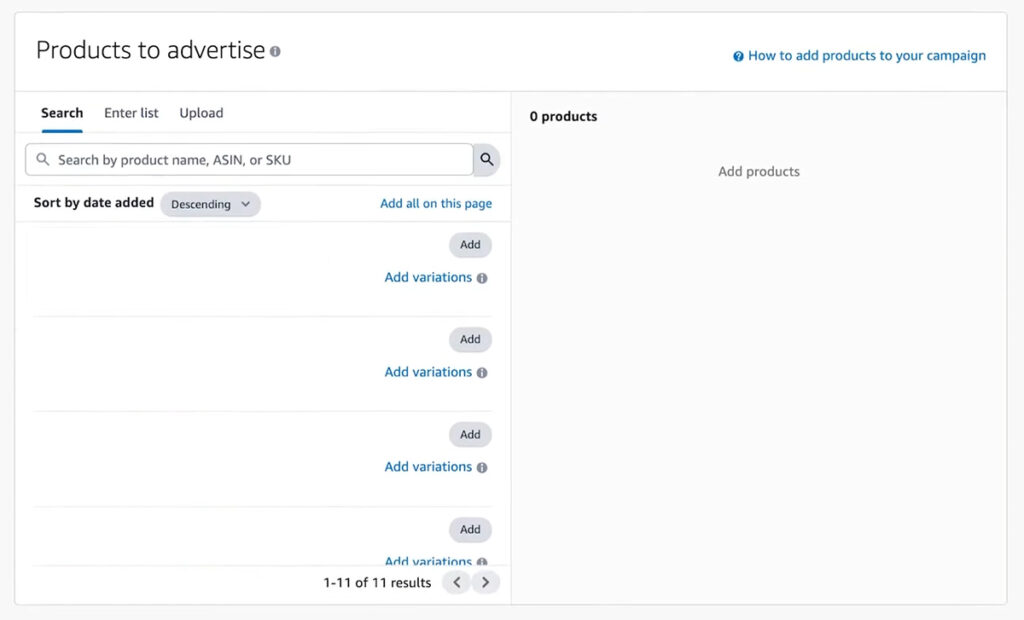
After you’ve chosen your ad format, you’ll need to select which landing page to use for your ads. You have the option of using a product detail page or sending shoppers to a page on your Brand Store. If you choose “Product Detail Page,” you will then be given the choice of which products to advertise.

My advice for this section is that, in most cases, you’ll want to go with a specific product detail page as your landing page. Unless you have a fully optimized Brand Store, it’s typically a safer bet to send shoppers directly from your advertisement to the product page with as little friction as possible.
Step 5: Choose Your Targeting and Bidding Strategy
Next up is targeting. We discussed this earlier, so we won’t go over it in detail again, but you’ll need to choose whether you want to use contextual targeting (categories and products) or audience targeting (interests, shopper behavior, retargeting).

If you select Contextual Targeting, you’ll be able to choose specific categories or individual products to target. This is helpful if you want your ad to show up directly on competitor listings or inside high-traffic category pages.
On the flip side, if you choose “Audiences,” you’ll get to use either Amazon Audiences, Page Visits, or Conversions as your options. If you’re goal is to set up a remarketing campaign, this is the option you’ll want to choose. For more information on each targeting option, please read our earlier section, “What Targeting Options Do Sponsored Display Ads Offer?”
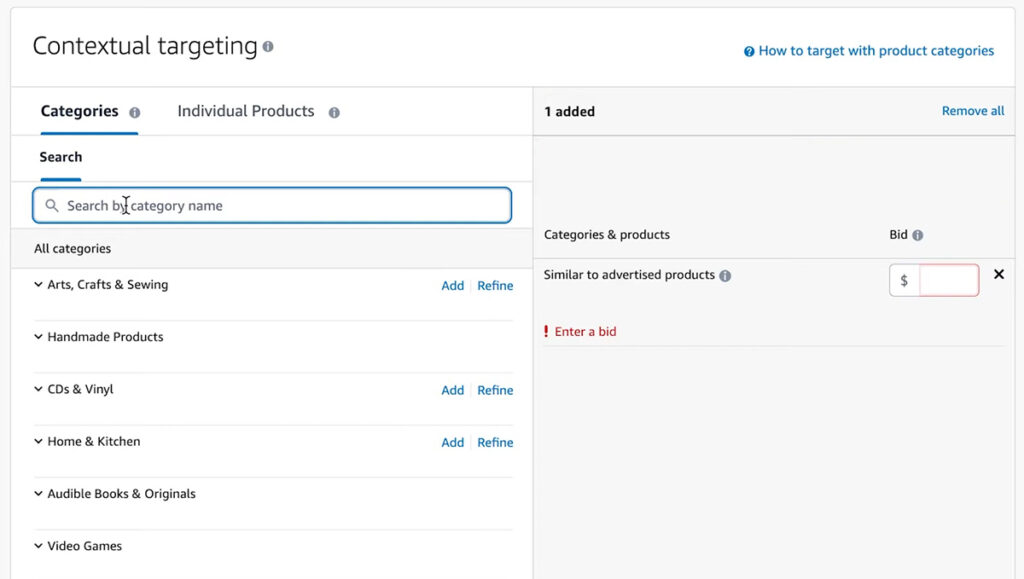
Once you’ve chosen your targets, Amazon will auto-fill a suggested bid for each one. I recommend ignoring these at first. They’re often inflated and can lead to unnecessary ad spend. Instead, start with a custom bid and monitor performance once the campaign is live.
Step 6: Set Up Your Creative
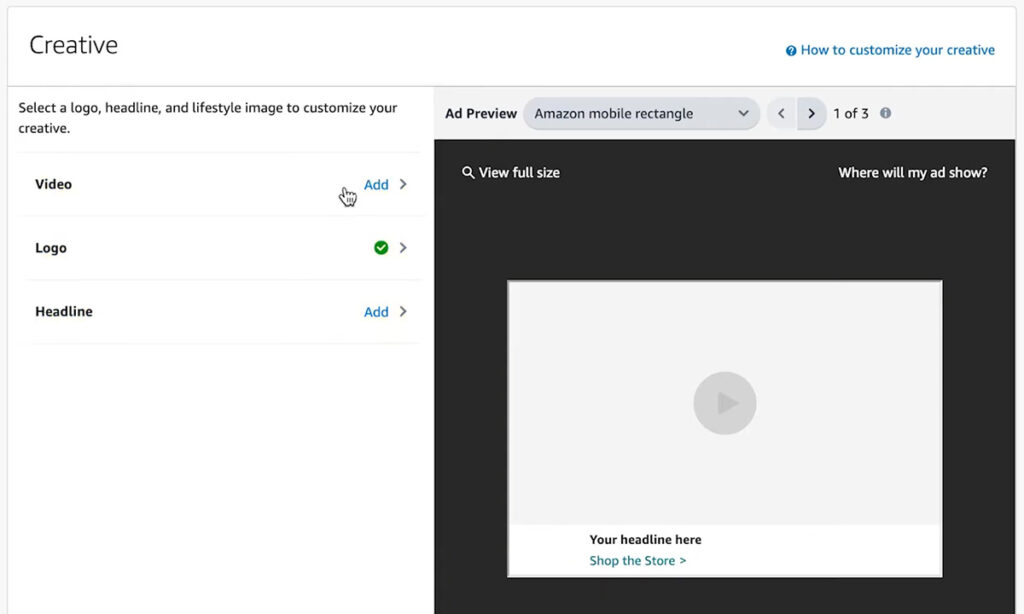
In the final step before finalizing your campaign, you will need to edit your ad creative. Whether you’ve chosen to create a video or image ad, the steps remain the same. You will need to add a:
- Headline
- Logo
- Image / Video
A custom image is optional for image ads. You can use one of your existing product images, generate a new lifestyle image using Amazon’s built-in AI tool, or upload a branded creative. Just make sure the image clearly shows your product and fits the ad space well.
For video ads, Amazon recommends a resolution of 1920 x 1080 pixels (16:9 aspect ratio). Keep it short, clear, and focused on your product in use. You can find all technical specifications for video ads in Amazon’s video requirements.
Once you’ve finished editing your creative and you’ve double-checked your campaign details, you’re ready to click “Launch Campaign.” Amazon will review your ad to make sure it meets their guidelines, and once it’s approved, it’ll start running automatically. Congrats, you’ve just launched your first Sponsored Display campaign!
How to Optimize Your Sponsored Display Campaigns
After your campaign setup is complete and your ads are live on Amazon, the next step is optimization. This is where you’ll double down on what’s working and trim away any wasted ad spend. No matter how much research and time you’ve put into setting up your campaign, there will always be things to optimize and test out as time goes by. Here’s what I recommend focusing on:
- Know Your Break-Even ACoS: Your ACoS (Ad Spend ÷ Ad Revenue × 100) shows if your ads are profitable. Aim to keep ACoS below your product’s profit margin. During a launch, you might accept a higher ACoS for visibility, but long term, focus on staying under break-even. To quickly calculate your ACoS, potential profits, max CPC, and more, check out our Free Amazon PPC Calculator.
- Start with High-Performing Products: Promote your top sellers first. These listings already convert well, so they’re ideal for retargeting. Then, gradually test less established ASINs by placing them on your best-performing product pages.
- Use Negative Targeting to Cut Wasted Ad Spend: Exclude audiences or product pages that burn budget without converting. This helps tighten your spend and improve return on ad spend (ROAS).
- Always Run a Retargeting Campaign: Sponsored Display’s retargeting options allow you to reach shoppers who viewed your listing—or even purchased from you—but didn’t convert. These campaigns typically convert better than cold traffic and are one of the most cost-effective ways to boost sales.
Are Amazon Sponsored Display Ads Worth It?
If your listings already bring in a solid amount of traffic, Sponsored Display Ads are absolutely worth testing, especially for retargeting.
As we covered earlier, Display Ads are the only Amazon ad type that lets you re-target shoppers who’ve already viewed or purchased your product in the past. When that targeting is paired with a listing that’s converting well, it can be one of the most efficient ways to boost your sales without increasing your top-of-funnel traffic.
In my experience, these campaigns tend to perform best when you already have consistent traffic on your listings. If your detail pages are optimized and you’re getting steady views, Display Ads give you a second (or third) chance to close the sale. It’s like following up with someone who was already halfway through checkout.
This is not to say that retargeting is the only good use of Display ads. Recently, we’ve seen a lot of success using Amazon’s audience targeting to reach cold traffic as well. However, if you’re a new seller with no advertising experience, you may want to focus on Sponsored Products first. These ads are easier to set up and are the backbone of any Amazon ad strategy.
If you are a new seller, our beginner’s guide to Amazon PPC will fill you in on the basics of advertising on Amazon and walk you through how to set up your first Sponsored Products campaign.
Frequently Asked Questions (FAQs)
How much do Amazon Sponsored Display Ads cost?
Amazon Sponsored Display Ads cost an average of $1.25 per click in 2025, but pricing depends heavily on your product and niche. For example, highly competitive categories like electronics or beauty can see CPCs (cost-per-clicks) over $2, while lower-competition niches like DVDs or gourmet food often stay below $1 per click.
Where do Sponsored Display Ads show up on Amazon?
Sponsored Display Ads can appear on the Amazon homepage, within search results, on product detail pages, and in other placements across Amazon. They can also show on external websites and apps like IMDb, Goodreads, and Twitch, along with thousands of third-party websites.
Should I use Sponsored Display Ads if I’m already running Sponsored Products?
Yes, combining Sponsored Display and Sponsored Products can be highly effective. Since both campaign types have different targeting options and different placements, your ads never compete with one another and can work together to drive traffic and sales.
Also, since Sponsored Display campaigns let you retarget shoppers who previously viewed your product, these campaigns often lead to better results than cold traffic. If Sponsored Products drive clicks, Sponsored Display can help recapture and convert those same visitors.
What’s the minimum budget to start using Sponsored Display Ads on Amazon?
Amazon doesn’t require a minimum budget for Sponsored Display Ads, so you can technically start with any amount. However, very low budgets can struggle to generate enough impressions to get results. I recommend starting with at least $10–$20 per day to get meaningful impressions and enough data to optimize your campaigns effectively.
Are Sponsored Display Ads worth it for new Amazon sellers?
It depends. If you’re a brand-new seller, start with Sponsored Products to get early sales and boost your organic keyword rankings. Once your listing gets traffic, adding Sponsored Display makes sense. You can then retarget shoppers who have already visited your page, improving conversion rates and ad performance over time.
Conclusion
Amazon Sponsored Display Ads are a powerful way to boost brand awareness, retarget high-intent shoppers, and drive more sales, both on and off Amazon. Whether you’re trying to bring shoppers back to your listing or expand your brand awareness, Display campaigns give you options that other ad types can’t.
Start with a budget that gives you room to test, and use performance data to optimize your campaign. With the right strategy, Sponsored Display can become a profitable part of your Amazon PPC toolkit.
Recommended Articles
- Amazon Sponsored Brands Ads – An Easy 7-Step Guide
- 7 Best Amazon PPC Tools Every Seller Should Know in 2025
- Brand Registry on Amazon: A Comprehensive Guide for 2025
Levi Adler is an experienced Amazon seller, e-commerce specialist, and the founder of Levi’s Toolbox. With over a decade in the trenches selling on Amazon and managing his own Shopify stores, Levi writes from his own experience. Sharing what worked, what flopped, and the strategies he wishes he’d known sooner. When he’s optimizing listings or managing ad campaigns, you’ll find Levi hitting mountain bike trails or hanging out with his two huskies, Emma and Scout.
